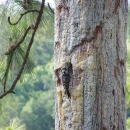About Us
The Banks Lake National Wildlife Refuge was established in 1985 under the Fish and Wildlife Act of 1956 and the Land and Water Conservation Fund Act of 1965. The refuge lies in the Grand Bay–Banks Lake (GBBL) ecosystem, an area that comprises the second-largest freshwater wetland system in Georgia. The GBBL area contains a number of unique ecological systems that support a variety of plants and animals, including freshwater and terrestrial federal- and state-listed species.
The refuge’s most notable feature is Banks Lake, a shallow blackwater lake studded with cypress trees that supports many fish species, as well as other aquatic animals. It was formed when the Carolina Bay that makes up most of the refuge was dammed over 150 years ago. The refuge contains a variety of habitat types, including cypress swamp, freshwater marsh, uplands, and open water.
Our History
Banks Lake lies in an area that, historically, consisted of a natural Carolina bay, which was likely created by tidal action of the ocean and then shaped by a more temperate climate prevailing thousands of years ago. In the mid-1800s, Joshua Lee built a low-level dam across the drainage creek on his property. The impounded water was utilized to power a grist mill to grind corn, wheat, and rice. The “mill pond” and accompanying mill established the area as a trade center along the early stagecoach route between Waycross and Thomasville, Georgia. In the 1920s, the E.D. Rivers family attempted to develop the area around the lake for electric power and home development. Cypress was logged from the lake to provide railroad crossties until the 1930s. In the early 1940s the dam was elevated, forming the existing Banks Lake, and a water control structure structure
Something temporarily or permanently constructed, built, or placed; and constructed of natural or manufactured parts including, but not limited to, a building, shed, cabin, porch, bridge, walkway, stair steps, sign, landing, platform, dock, rack, fence, telecommunication device, antennae, fish cleaning table, satellite dish/mount, or well head.
Learn more about structure /spillway was installed to maximize the water level at approximately 190 feet (58 meters) above mean sea level (MSL). In the 1970s, the E.D. Rivers Estate proposed to drain the lake and harvest the “lightered stumps” and cypress trees. The proposal to drain the lake and remove cypress trees never materialized. Instead, The Nature Conservancy purchased the land from the E.D. Rivers Estate on March 14, 1980.
On April 16, 1980, the Service entered into a lease agreement with The Nature Conservancy to manage approximately 3,559 acres (1,440 ha) of the Banks Lake/Grand Bay wetlands complex, located in Lanier and Lowndes Counties in southeastern Georgia. The original intent of the lease was to establish a national wildlife refuge national wildlife refuge
A national wildlife refuge is typically a contiguous area of land and water managed by the U.S. Fish and Wildlife Service for the conservation and, where appropriate, restoration of fish, wildlife and plant resources and their habitats for the benefit of present and future generations of Americans.
Learn more about national wildlife refuge . Changes in the emphasis of the land acquisition program resulted in a lack of funds necessary to acquire the land. The area remained in a state of limbo during 1982 and 1983, with the Service maintaining a caretaker position over Banks Lake. In 1984, funds were added to the fiscal year 1985 budget for purchase of the site at a value of $356,000. The refuge designation was authorized under the Fish and Wildlife Act of 1956 and funded through provisions of the Land and Water Conservation Fund Act of 1955, with strong local support from the Lakeland community and the congressional delegation. The area became Banks Lake National Wildlife Refuge on February 22, 1985.
Other Facilities in this Complex
Banks Lake National Wildlife Refuge is managed as part of the Okefenokee Complex.

